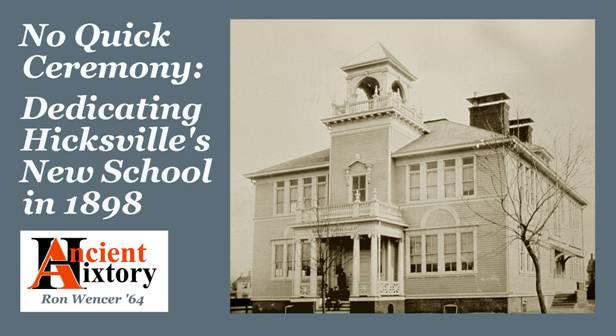
Union School, Hicksville, as it stood 1898 - c.1908
The image above was derived from two online digital images in
the Hicksville Public Library Collection at New York Heritage.
The first bears identifier M1616; the second (no identifier
listed) is essentially a mirror image of M1616.
During 2020 and 2021, numerous dedication ceremonies have been deferred because of the pandemic (e.g., that of Hicksville's Vietnam War Era Memorial). In contrast, back on January 3, 1898, nothing impeded the dedication of Hicksville's new school building on West Nicholai Street. Moreover, those who attended the ceremony that day "got their money's worth." Before being given tours of the building, they heard a number of speeches, enjoyed several musical performances, and listened to more than a dozen students recite declamations, which were a hallmark of scholastic ceremonies in the nineteenth century.
***
Background: Declamation
From the beginnings of democracy in ancient Greece, societies who proclaimed or elected their leaders wanted their people to comprehend the art of rhetoric - the ability to persuade others through words and argument. If rhetoric prevailed, then the vote of the populace might be swayed by good ideas, not by personality or bribes.
Rhetoric did not always prevail, but in the history of Europe its thread ran from Greece to Rome, through the Renaissance, and eventually into the modern era. Along the way, over the centuries when most people were illiterate, making a speech was the only tool by which ideas could be presented to the masses. Certain ways of formal speaking in formal settings became standard, which resulted in an emphasis on teaching declamation - a rather theatrical manner of speaking, which (in theory) engages the audience by using physical gestures, and by carefully modulating one's voice.
To us, this emphasis on how to speak one's words, rather than on choosing them, may seem a bit silly. But in the Victorian era, Declamation was taught early, even in the lower grades of elementary school. There were established age-appropriate readings, often in the form of poems, to be declaimed by children. For older children, these readings sought to evoke a noble sentiment; for younger children, they evoked simple sadness or joy. All of them tried to promote morals and proper social behavior. The idea was that by learning early how to hold the attention of an audience, a child might grow up to someday be a respected orator, like William Jennings Bryan. Material to read was in such demand that by the 1880s, for twelve cents one could order by mail one of the several volumes of Standard Recitations by Best Authors from a publisher in lower Manhattan.
The following piece - I cannot in good conscience call it a poem - was read at the school dedication on Nicholai Street by Richard Sutter, 12, son of local stone mason Daniel Sutter. It had appeared in the Journal of Education for May 21, 1896, where it was printed alongside an article called "Teaching Children to Think." Some Hicksville educator had likely seen it in that journal, and set it aside, to be declaimed by a student on some future suitable occasion.
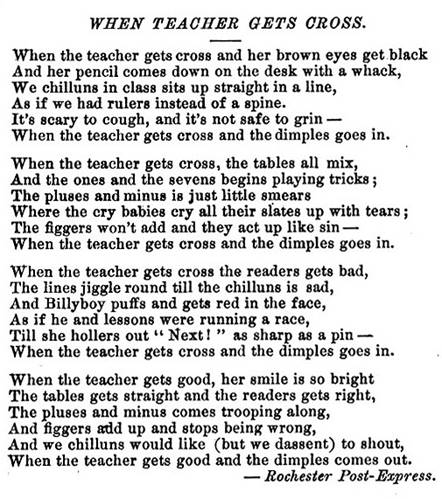
found online at https://www.jstor.org/stable/44047740
***
Music, a Call to Order, Prayer, and Speeches
The Brooklyn Daily Eagle, January 3, 1898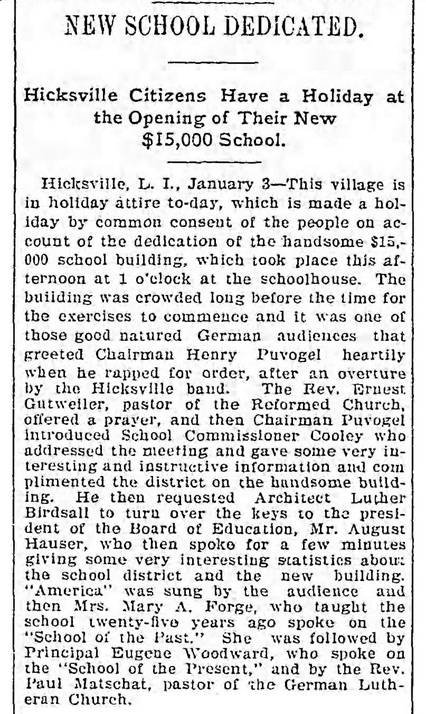
It is understandable that the reporter characterized the audience for the event as German. The influx of suburbanites was still more than a decade away; for now, almost all the village's officials, stores, employers, and clergy bore German names. As we'll see, the children who participated in the program all belonged to German families as well. Note that the Hicksville Band was a marching brass band, and it fit right in, happy to oom-pah and parade whenever it was given the chance.
It may be worth noting here that in 1898, the United States still had no official national anthem. In this era, America - the melody of the British God Save the King / Queen, but with the lyrics that began with the words "My Country Tis of Thee..." - typically served in that capacity, and it did in this case.
More noteworthy is the reference to Mary Forgie. Local history sources tend to gloss over the details of village's early efforts to educate its children. Even the Evers' Images of America book about Hicksville includes references only to early schoolmasters (all male), but names no women who taught in the village's early Germanic years. I regret that the Eagle's article gives us none of Mrs. Forgie's insights about her experiences back then.
So that she may be a little less forgotten, I have done some preliminary research into her life, which I include in a brief Appendix at the end of this article.
***
Music and Moralizing
With the conclusion of the speeches, one might think that everything that had to be said up front had been said, and that a formal tour of the new building could begin. That was not the case, however - after all, even Super Bowl fans seem to think that a half-time show is necessary.
In this instance, the "half-time show" consisted primarily of 15 carefully rehearsed student recitations, each complete with declamatory gestures and exaggerated facial expressions, of well-worn writings that were didactic, and often joyless. Allowing on average six minutes for each speaker to rise, walk forward, declaim, accept applause, and return to a seat, we can assume that the recitations in total took at least 90 minutes to complete.
The Brooklyn Daily Eagle, January 3, 1898
The declamations were punctuated by musical performances. The first of the latter was a piano rendition of Marching Through Georgia, which would have stirred the audience, amongst whom were a number of Civil War veterans (none of whom, one hopes, had worn gray and fought for Georgia). There was a solo of The Star-Spangled Banner, sung by Jennie Hahn, 10, daughter of merchant John Hahn. Also on the program were another piece (unnamed) on the piano, and two numbers played by the band. The first of the latter was Red, White and Blue; so many pieces of music have used these words as a title or subtitle that one cannot be certain which of them was played. The second was Listen to the Mockingbird (if I am not mistaken, in the 1960s television series The Prisoner, this was one of the recurring pieces of "uplifting" music played in The Village). Note that the pianist for this part of the dedication, Blanca Kreuscher, was not local; she was part of a well-known German family that owned a hotel in the Rockaways.
Fortunately for the reader, I have not located the texts of every item that was declaimed, and thus I can inflict only a few more examples on you. The first was performed by Adam Lauck, 14, whose mother was a cutter of silver leaf. He had the misfortune of presenting this long and over-sentimental item:
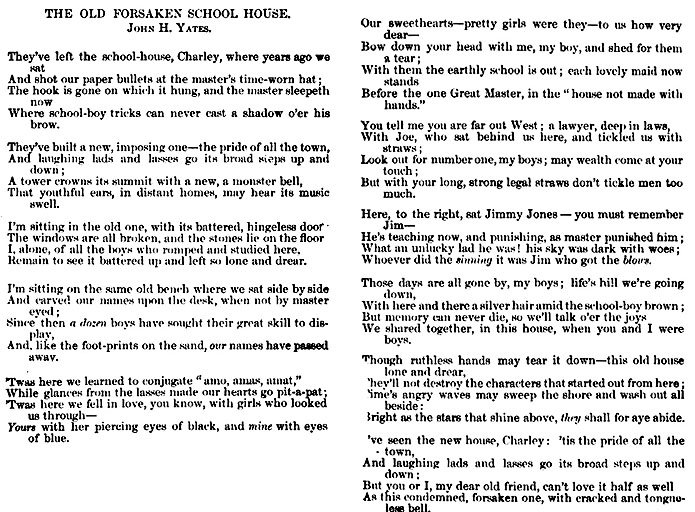
The Speaker's Garland, edited by Phineas Garrett
Volume II, 1892
Andrew Heberer, 10 years old, and son of the storekeeper of the same name, got to read this version of the old grasshopper-ant theme:
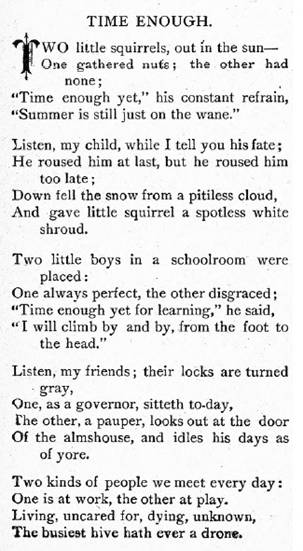
Delightful Stories of Travel at Home and Abroad etc.,
edited by Allen E. Fowler, 1895
Part VI Elocution Exercises
You may have noted that the above rather cautionary tale was included in an anthology of supposedly "delightful" stories. Similarly, J. Ofenloch (who was either John or Joseph, both about 11 years old and sons of blacksmith Philip) got to read The Contrary Boy, a painfully long tale of a spoiled little fellow, printed in an anthology from 1853, which somehow was called The Favorite Story Book, or Pleasing Sketches for Youth. I am profoundly grateful that when I was 11, I was not forced to read such a thing - I would have been compelled (and ready) to argue with my teacher that the following excerpt, and in fact the entirety of the piece, has no place in any collection of "pleasing sketches."
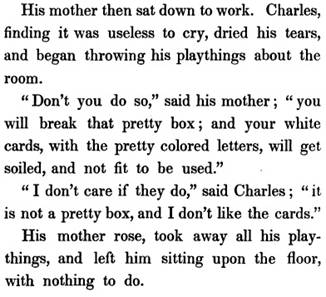
One of the more upbeat portions of "The Contrary Boy"
The Favorite Story Book, or Pleasing Sketches for Youth
edited by Clara Arnold, 1853
***
Inspection (i.e., Guided Tour) of the Building, and Then the School Board Kicks Back
The Brooklyn Daily Eagle, January 3, 1898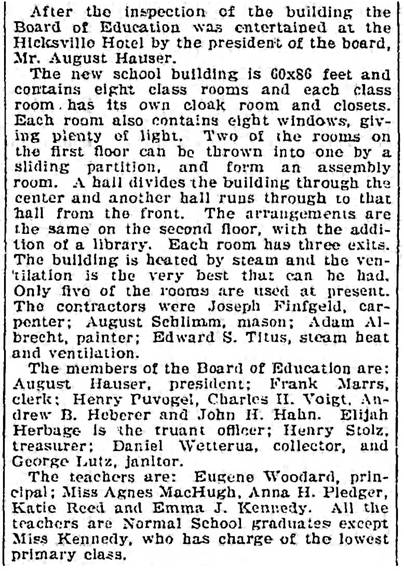
Reading the above, one wonders if the length of time devoted to student recitations had anything to do with the fact that 7 of the children chosen to recite were offspring of members of the School Board.
***
Conclusion
Within a very few years, as City dwellers began buying new homes in anticipation of the railroad tunnels that would make commuting realistic, the Union School would become as overcrowded as its predecessor had been. Even with the second building on Nicholai Street, which effectively doubled its capacity in 1910, the school would remain overcrowded until the 1920s, when East Street School and the Junior/Senior High School were constructed.
This growth in demand should not overshadow the magnitude of change which the 1898 Union School represented for Hicksville. The building was large for the immediate needs of the day (i.e., only 60% of the rooms were used at first). Its large window area, compact design, and clever touches (e.g., the convertible classrooms/assembly area) were up-to-date for a rural school, and as built, it was a rather handsome building. The School Board members were entitled to indulge in a little mutual back-slapping after the dedication ceremony. If only they had been willing to cut short those declamations...
***
Appendix: A Brief Look at Mary Amelia Brierly
Mary A. Brierly - later Mrs. Mary A. Forgie - was born in 1839, in Washington County, New York, several miles east of Glens Falls. Her father was a shoemaker from Michigan; her mother had been born in Canada.
She taught in at least two places: in the 1870s at the Union School in Hicksville, and around 1880 at the Academyat Glens Falls.
Glens Falls Academy, c.1880
Collection of Chapman Historical Museum
https://chapmanmuseum.pastperfectonline.com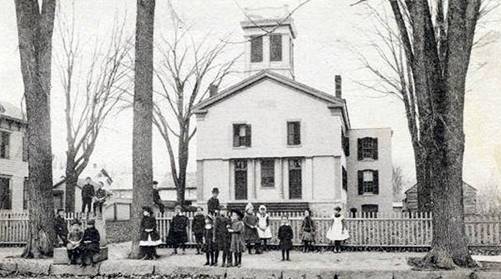
She also may have taught elsewhere on Long Island: at the time of the 1870 U.S. Census, she was living in the Township of Oyster Bay and working as a teacher. This would be three years earlier than the newspaper account of the Dedication ceremony states she had taught at Hicksville.
In Glens Falls, on May 13, 1884, she married a widower, one John Forgie. As early as the 1850s, Forgie had worked in Hicksville, selling real estate and conducting estate auctions. He must have had a curious, active mind, for in 1876 he was granted a patent for a new type of propeller to be used on boats and ships. In the 1890s, he ventured into the metal-beating business, opening a shop on a property near Jerusalem Avenue and Newbridge Road. It manufactured no gold leaf, but it did produce silver leaf, and also something new: aluminum leaf. The latter was thought quite desirable for applying to the edges of the pages of bound books, as unlike silver, aluminum would never tarnish.
After returning to Hicksville, Mary became a respected and well-liked member of the community. She was remembered fondly by her one-time students, who by now were active in business and local government. In the mid-1890s, she was likely the only woman who sat on the committee that determined how much tax-based funding the village's School Board would receive to build and operate the new school. She also was active with many charities, especially ones that helped young children. When the Spanish-American War began, disease ran through the troops quartered at nearby Camp Black in Garden City. Mary regularly made the trip to the camp to "look in on the boys" and bring them little gifts.
Life became hard for her after her husband died. During his final illness, he had changed his will, which laid the groundwork for legal proceedings that would pit Mary against the children from his first marriage. The children won, and she soon was nearly penniless. She tried starting her own silver leaf business, but her age and health did not permit her to succeed for very long. Major cancer surgery in 1904 led to a slow and only partial recovery; in 1907 she moved back to Glens Falls to live with a niece. At that time, the people of Hicksville appreciatively gave her a send-off, including a financial gift in honor of her years of kind service to the village.
She died in 1909. Three days later, this tender note about her appeared in the Long-Islander:
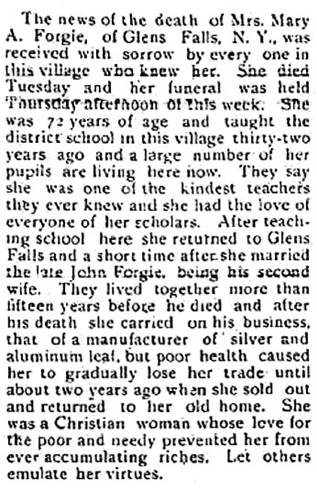
Huntington Long-Islander, March 19, 1909
*****

